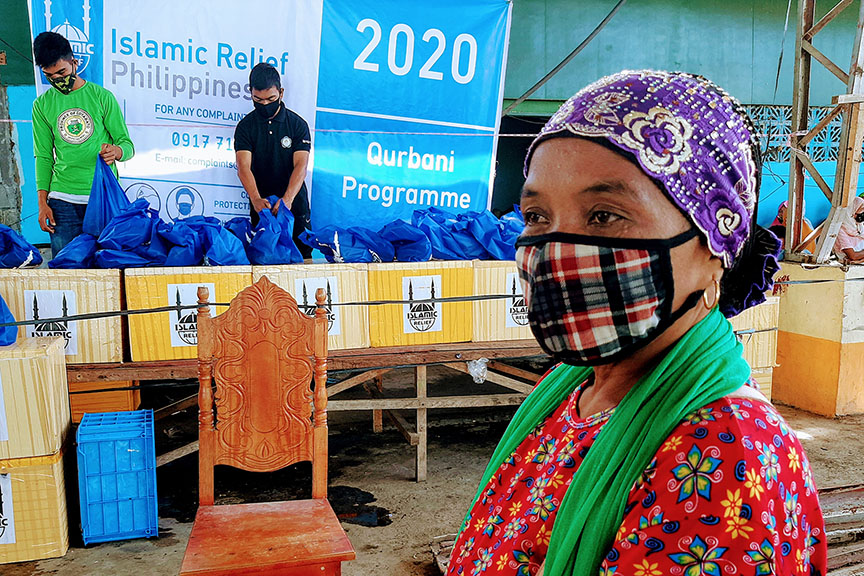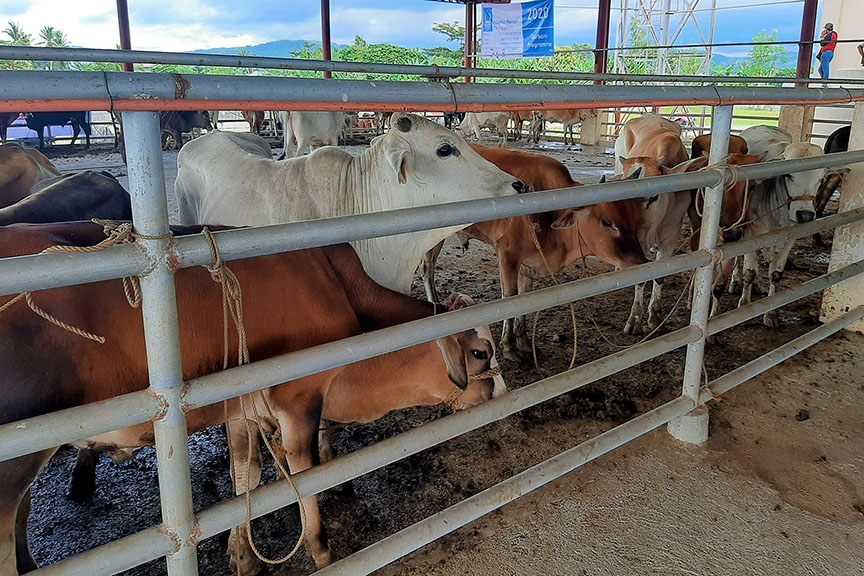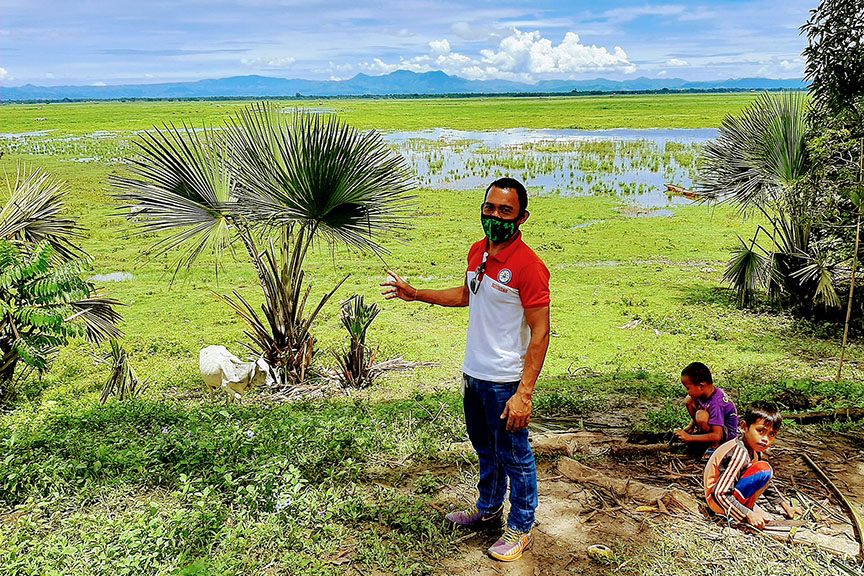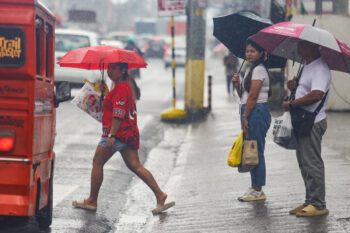MIDSAYAP, North Cotabato (MindaNews / 5 Aug) – As a solo parent to nine children, Kabilangan Mamasapalao, 49, considered a family meal involving beef dish to be luxury. For almost a year now, her family whose source of income is farming a small untitled farm lot, never had beef viand in the dining table. However, as part of the Eid’l Adha, the family’s meal will be special. “Magluluto po ako ng nilaga at ng sinina (a spicy beef dish cooked in ginger, grated coconut and other herbs),” the widow said.
 Qurbani meat recipient, Kabilangan Mamasapalao, 49, solo parent to nine children, considers beef dish a luxury. With the two kilos of Qurbani meat that she received, she planned for a feast for the family. Photo taken 2 August 2020. MindaNews photo by JULES L. BENITEZ
Qurbani meat recipient, Kabilangan Mamasapalao, 49, solo parent to nine children, considers beef dish a luxury. With the two kilos of Qurbani meat that she received, she planned for a feast for the family. Photo taken 2 August 2020. MindaNews photo by JULES L. BENITEZ
Mamasapalao is one of the 3,639 family-beneficiaries from nine barangays in Midsayap who opted to join the Bangsamoro Autonomous Region in Muslim Mindanao (BARMM) who received two kilos of Qurbani beef from Islamic Relief Worldwide-Philippines (IRW-Philippines), an international non-government humanitarian organization with country office in Cotabato City. The organization also distributed Qurbani packs to COVID-19 isolation facilities in Maguindanao and to 1,115 Internally Displaced families in the Municipality of Salibo of the same province.
Those in the quarantine facilities are mostly Locally Stranded Individuals (LSI) who returned from Metro Manila recently and were subjected to a 14-day quarantine period.
The internally displaced persons (IDPs), on the other hand, were displaced by the July 29 operations waged by the Armed Forces of the Philippines against the elements of the Bangsamoro Islamic Freedom Fighters (BIFF) in the area within and around the adjoining towns of Shariff Aguak, Pagatin (Datu Saudi Ampatuan), Mamasapano and Salibo, which the AFP labeled as the “SPMS Box”. The IDPs came from barangay Penditen of Salibo and sought refuge in barangays of Ganta, Pandi and Mutilen of the same town.
Sittie Montud, OIC Country Director of IRW-Philippines, said that funds for the Qurbani Meat Distribution come from donations of Muslims from various countries as part of their annual performance of Qurbani following Islamic teachings.
The BARMM Chief Minister Ahod Balawag Ebrahim, better known as Al-Hajj Murad Ebrahim, in a message delivered in his behalf by Kelly Antao, Administrator of the 63 new BARMM barangays located in North Cotabato, during the Qurbani distribution, acknowledged the hardships faced by the Bangsamoro communities amid the COVID-19 pandemic and how the tradition of Qurbani tides the difficulties.
Addressing the Muslims of the international community who gave their Qurbani to the Bangsamoro communities, the Chief Minister said, “Kami po ay nagpapasalamat dahil malaking tulong sa ating mga kapatid na Bangsamoro ang ibinahagi ninyong Qurban lalo na sa panahon ngayong nalimitahan ng pandemiya ang pangunahing pinagkukunan ng kabuhayan ng ating mga kababayan.”
To the Bangsamoro constituents, the Chief Minister assured them that the current development processes being developed by the BARMM Government is based on the needs of the communities. He said, “Asahan niyo po na ang aming pagbabalangkas sa Pamahalaang Bangsamoro ay nakaangkla sa pangangailangan ng bawat komunidad at gagawin po namin ang lahat upang maipalapit ang Bangsamoro Government sa mga mamamayan.”
Modern Day Qurbani Practice in BARMM
The practice of offering Qurbani meat to less privileged members of the community started in the time of Prophet Abraham, who scholars estimated to have lived 2,000 years before Christ. According to the Christian, Jewish and Muslim narratives, Abraham was asked by God to offer his favored son Ishmael (Isaac in Christian accounts) as a sacrifice. Religious scholars interpreted this as a test of Abraham’s obedience to God. When he was about to slaughter his son in the altar at Mt. Moriah, God intervened in the last minute and spared Abraham’s son. In his stead, a ram was sacrificed. This is referred to as the “Day of the Sacrifice” in Islam, according to Ustadz Montaser Paki, executive assistant of the Bangsamoro Grand Mufti Abu Huraira Udasan of the BARMM Darul Ifta.
 FULL HOUSE. The Cotabato City Slaughter House, photogrpahed 31 July 2020, reaches full capacity during the Eid’l Adha with cows and goats intended for Qurbani meat distribution. MindaNews photo by JULES L. BENITEZ
FULL HOUSE. The Cotabato City Slaughter House, photogrpahed 31 July 2020, reaches full capacity during the Eid’l Adha with cows and goats intended for Qurbani meat distribution. MindaNews photo by JULES L. BENITEZ
Following the Sunnah (The Way of the Prophet) in Islam, the offering of Qurbani meat – which can only be sourced from camels, cows, sheep or goats – was then practiced to commemorate the Day of the Sacrifice. Some Muslim scholars consider the practice as obligatory, which means that every Muslim is required to offer a Qurbani meat at least once in his or her lifetime, while others consider it as “obligatory but according to the individual’s capacity to do the offering,” said Ustadz Paki.
In the present day BARMM, within the period of three days from the day of Eid’l Adha (Festival of Sacrifice), the halal-certified slaughter house in Cotabato City is a sight of flurry of people bringing in cows and goats for slaughter following halal procedures. Muslims have only a three-day window during this festival to offer their sacrifice in the form of Qurbani meat.
Ustadz Bajunaid Palot Ibrahim, 59, one of the two ustadz in the slaughter house, consider this period as the busiest days of the year. He had been working there as an essential staff requirement for halal certification employed.
In slaughtering cattle meant as a Qurbani, Ustadz Ibrahim said that certain procedures are strictly followed in order for the meat to be acceptable as a sacrifice.
“First the cattle, whether goat or cow, should be healthy; not too young and not too old,” the Ustadz said. They are bathed before bringing in in the slaughter area. When they are brought inside the slaughter area, their eyes are covered so that the animal will not be able to see other animals in the process of being slaughtered. “This way, the animal will not be afraid,” he added.
Ustadz Ibrahim further explained: “In slaughtering, the officiating Ustadz will recite a prayer, mention the names of those offering the sacrifice. The heads of the cattle are positioned comfortably so that the kill can be made swiftly. The slaughtered animal is then drained of its blood; the internal organs and the head are then disposed and only the prime body parts are processed into Qurbani meat for offering to the less fortunate.”
In addition, Ustadz Ibrahim explained that the halal standards in cattle slaughtering and processing is being strictly followed. This included sanitary and hygiene practices. Amid the COVID-19 pandemic, only personnel of the slaughter house are allowed inside the processing areas to mitigate on possible contamination.
Razul Masulot, manager of the slaughter house, said that during the recently concluded Eid’l Adha, they processed around 250 heads of cows for Qurbani purposes. In regular days, the number of cows being slaughtered only averages to 15 heads. The city government charges a service and users’ fee of P970 per unit of cows processed and P275 per unit of goats.
“Almost 90% of the clients during this period are humanitarian and development organizations like the IRW-Philippines and the Bangsamoro Development Authority (BDA) who are engaged in Qurbani distribution. The manager had to turn down individual clients because the facility has reached its full capacity.
The distribution of Qurbani meat during the Eid’l Adha had always been a challenge for humanitarian organizations like IRW-Philippines in mainland BARMM. First is the challenge of finding enough number of cows for the sacrifice in a short period of time. Second is finding halal-certified slaughter house that can accommodate huge number of cattle for processing.
Dreaming of a Ranch for Qurbani
In Kadingilan, one of the nine barangays who received Qurbani meat from IRW-Philippines, Saiden Alim, 34, the punong barangay, dreams of establishing a cattle ranch for cows and goats and a halal slaughter house in his community. He pointed towards an expanse of roughly 400 hectares of flat land as the site for his vision. The land is currently classified as public land, which the local residents have collectively sought to be distributed to local residents.
 Setting his vision on this 400 hectares of public land, Punong Barangay of Kadingilan, Saiden Alim, 34, dreams of establishing a ranch for cows and goats and a halal slaughter house in his community that can supply Qurbani meat during Eid’l Adha. Photographed 2 August 2020. MindaNews photo by JULES L. BENITEZ
Setting his vision on this 400 hectares of public land, Punong Barangay of Kadingilan, Saiden Alim, 34, dreams of establishing a ranch for cows and goats and a halal slaughter house in his community that can supply Qurbani meat during Eid’l Adha. Photographed 2 August 2020. MindaNews photo by JULES L. BENITEZ
Speaking in Tagalog, Alim said, “We hope that the Department of Environment and Natural Resources (DENR) can already release this land to us so that we can finally make this area more productive.” Currently the local residents utilize the area as pasture land for cows and goats, corn plantation and, during the wet season, as fishing ground.
Alim said that his great grandfather, Pagao Kadtog, opened up the area as pasture land and corn plantation.
The barangay has proposed for the construction of a mega dike to cut across the flat land to control the influx of water during the wet season and also serve as barangay road to grant easier access to the field. “Each of the families in the barangay will be given a portion of land to till there,” Alim said.
The Punong Barangay hopes that the BARMM government will support their development plan. More than half of the residents of this barangay are members of the Moro Islamic Liberation Front.
If the barangay government will be successful in having DENR apportion the land to the residents, it will be the first land distribution program of BARMM.
“When this happens, we can provide cows and goats for Qurbani during Eid’l Adha at the same time provide livelihood opportunities for our people. (Jules L. Benitez is the Manager of the Peacebuilding Project of IRW-Philippines and is a MindaNews contributor.)
